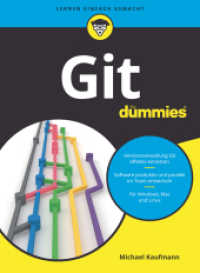Full Description
Freedom to Move is an evidence informed practical resource which provides movement therapists of all disciplines with an exercise blueprint for rehabilitating spinal pain and many related 'injuries'.
In essence, Freedom to Move describes what goes wrong in the spine and what to do about it. It integrates the applicable contemporary neuroscience around spinal movement and pain with the clinical evidence and understanding gained from the author's enquiring practice, and her exploration of various movement approaches and their contribution - or otherwise, to spinal well-being.
It examines the relationship between healthy torso structure and functional control and describes and explains the author's model of spinal dysfunction - the remediation of which forms the basis of the author's model of care for the spine, The Key Approach®.
The book's main focus is on a practical, therapeutic exercise/movement approach which addresses the common movement faults and dysfunctions observed in people with spinal pain and stiffness.
In particular, the Fundamental Patterns of control are introduced as important, innate 'key' movements which naturally provide the sound foundations necessary for a healthy spine - but which have commonly been 'lost' in the movement repertoire of people with spinal pain syndromes.
These are re-established and reincorporated into various poses, movements and stretches by way of specifically directed mindful movement explorations. The client is helped to regain more optimal function and move out of pain - with more freedom.
The approach is applicable within all industry models of teaching therapeutic movement: in the rehabilitation of spinal pain within physiotherapy, Pilates and Yoga; and in the fitness industry, for injury prevention, health promotion and optimising spinal health in exercise programmes in general.
Contents
Acknowledgements
Introduction
Glossary of terms
Glossary of abbreviations
Part A Laying the groundwork for an enhanced understanding of the spine in health and disease
Chapter 1 The spine: Its role in movement and musculoskeletal pain
Chapter 2 The vertebral axis: A marriage between biotensegrity and neuro-motor control
Chapter 3 Defining the problem: What goes wrong in the spine that leads to pain?
Chapter 4 The Key fundamental patterns of the torso: The basic movements supporting healthy spinal control
Part B Getting to work re-building enhanced spinal movement control
Chapter 5 Assessment: Altered movement behavior is often hiding in plain sight.
Chapter 6 Key Moves 1: Principles and practice of movement therapy for spinal rehabilitation
Chapter 7 Key Moves 2: kinesthetic therapeutic movement exercises for spinal health and wellbeing
Chapter 8 Waking up the spine: Further aspects of control in movement therapy
Chapter 9 Constructing a class
Chapter 10 Changing movement behavior: Mindfulness, perception and felt sense








